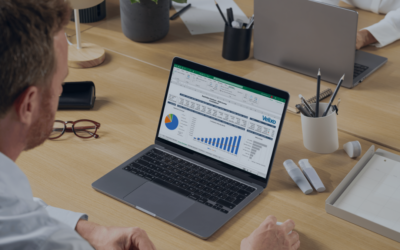If yours is one of the many small businesses considering Enterprise Resource Planning (ERP) systems, chances are you have given some serious thought to cost. As a business, your first concern must always be whether investing in an ERP will be worth it in the long term for your bottom line. ERP is an investment that can reap serious dividends for your business operations. How do the numbers play out, however, and how does ERP justification work? Let’s look at the math for calculating the ROI of an ERP replacement.
Why this type of ERP justification is especially critical when deciding whether to keep or replace existing software
Running the numbers of an ROI calculation is crucial when deciding whether to hold on to existing ERP software or invest in a replacement. It enables them to make informed decisions about the potential return on investment and determine if it is worth the cost in the long term.
By calculating the ROI of an ERP replacement, businesses can estimate the total costs and benefits of implementing a new system over a specific period, such as five years. This calculation involves comparing the total benefits, which may include increased efficiency and revenue, to the total costs, such as licensing fees, infrastructure costs, implementation costs, and ongoing maintenance costs.
If the ROI percentage is high, it may indicate that investing in a replacement ERP is a better option than continuing to use the existing software. Additionally, businesses can calculate the cost of ERP, considering factors such as licensing fees, infrastructure costs, implementation costs, and ongoing maintenance costs, to determine which option is more cost-effective. Working with the right ERP partner can help businesses to accurately estimate the upfront costs and ongoing expenses of each option, allowing them to make informed decisions.
How it’s done: calculating the ROI of an ERP Replacement
To calculate your potential return on investment of an ERP, let’s assume a total cost of $100,000 for a mid-sized business. The savings that would result from implementation of that ERP thanks to increased efficiency, revenue, et al. would total $150,000 over five years.
If you divide your total benefits by total costs, you get an ROI of 150%. As an alternative, you could also divide net profit by total costs delivering an ROI of 50%, or an average of 10% per year. Keep in mind that, given the upfront costs of many ERP solutions, the first year ROI may well be lean, with benefits increasing year by year.
In summary:
Method 1
Return on Investment (ROI) = Total Benefits / Total Costs
Total benefits = $150,000
Total costs = $100,000
ROI = $150,000 / $ 100,000 = 1.5 or 150%
Method 2
Net Profit by Total Costs
Net profit = Total Benefits – Total Costs
ROI Gain = (Net Profit / Total Costs) x 100
($150,000 – $100,000) / $100,000 = .50 or 50%
You can also calculate ROI using a ‘payback’ method that reflects how long it will take your new ERP to pay itself off. Your payback period is easy enough to calculate and involves dividing the cost of the system by your annual return. Based on our original numbers, your payback period would be around 3.33 years.
Calculating the Cost of an ERP replacement
All that being said, what will your costs be if you transition to ERP? There are four central components involved in ERP pricing:
- Licensing Fees: This refers to the fees charged by the ERP vendors for the right to use their software. The licensing fees may be charged on the number of users or which modules you buy In general, however, there are two main types of ERP licensing perpetual and SaaS.
A perpetual ERP license is a traditional licensing model where the customer pays an upfront cost to own and use the software indefinitely, while also being responsible for maintaining the system.
In contrast, a Software-as-a-Service (SaaS) ERP license is a subscription-based model is common with a cloud based ERP. Here, the customer pays a recurring fee for access to the software, and the vendor manages the system maintenance and upgrades. The SaaS model offers more flexibility and lower upfront costs, while the perpetual license offers greater control over the system and may be more cost-effective in the long run.
- Infrastructure Costs: Infrastructure costs refer to the hardware and software required to host the ERP system. Depending on the ERP type (more on that in a minute) and the vendor’s pricing model, infrastructure costs may include computers, servers, storage devices, networking equipment, and other components necessary to run the ERP system. In some cases, businesses may choose to host their ERP system in the cloud, in which case they may need to pay for cloud-based infrastructure services from a third-party provider.
- Implementation Costs: When you choose to implement an ERP system there are a variety of costs associated with the project. ERP implementation costs can include consulting fees, customization costs, data migration expenses, and training costs. Implementation costs are usually a significant part of the overall cost of an ERP system and can vary depending on the complexity of the implementation.
- Ongoing Maintenance Costs: Ongoing maintenance costs refer to the operating expenses associated with maintaining and supporting the system after successful ERP implementation. These costs can include IT support, software updates, hardware upgrades, and ongoing training for users. Ongoing maintenance costs can be a significant ongoing expense for businesses and are an important consideration when evaluating the long-term costs of an ERP system.
The role of ERP type on cost
Which type of ERP solution you settle on directly affects each of these. You have three main options to consider in selecting an ERP system: cloud-based, hybrid and on-premises. We looked at the differences between these options and which of these ERP solutions is the best fit for your company in a previous blog post.
A complete cloud ERP, for example, ameliorates cost significantly across all four cost sectors. A hybrid solution which combines on-premises infrastructure with cloud-based components, shaves a bit off. Any on-premises ERP will involve significant upfront investment and require sizeable ongoing costs for staff and maintenance.
Whichever approach to ERP ROI calculation you decide to take, working with the right ERP partner can make all the difference. They can help you determine which approach works best for your company and give you a realistic picture of your upfront costs.
What experiences have you had with ERP and calculating the ROI of an ERP replacement? Let us know in the comments below. To explore your own ERP options, visit this webpage.



